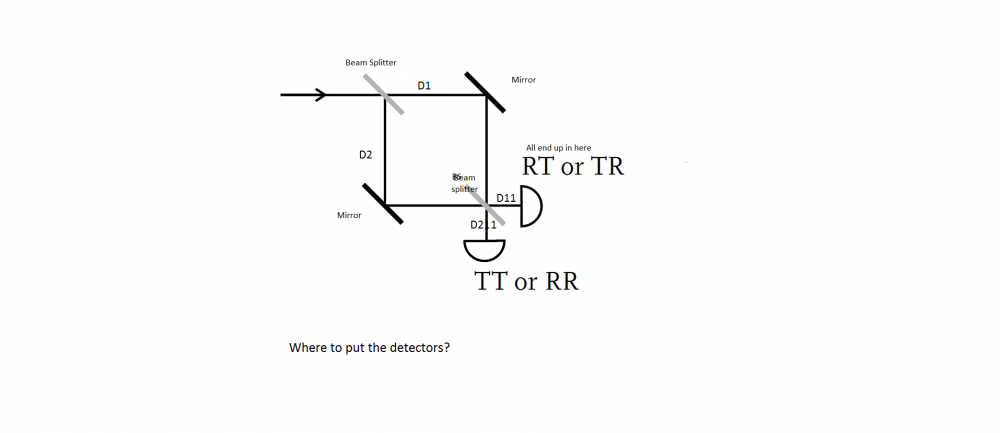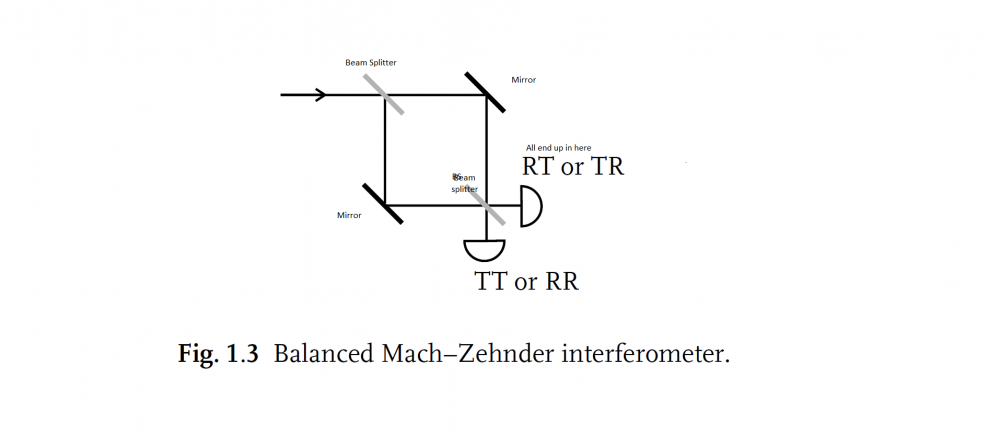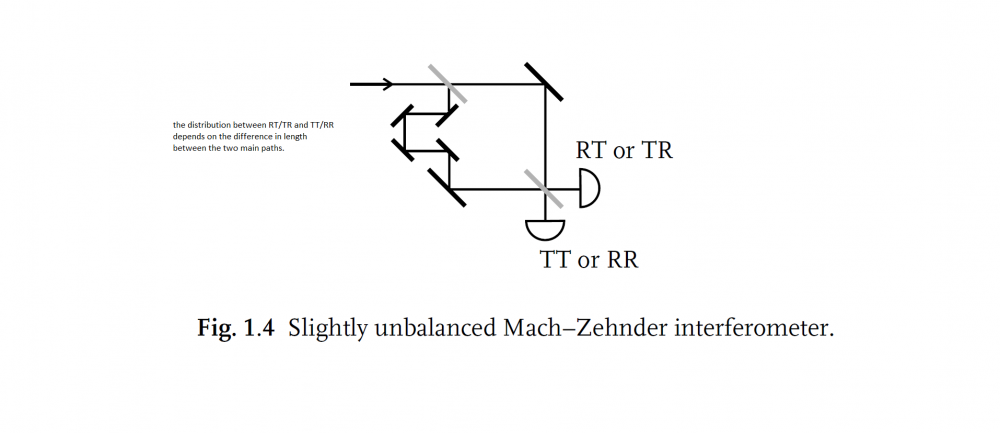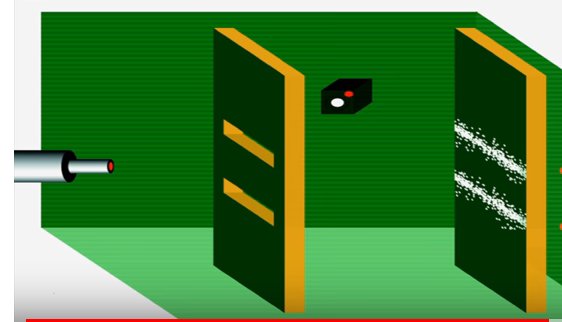

Dalo
-
Posts
413 -
Joined
-
Last visited
Content Type
Profiles
Forums
Events
Posts posted by Dalo
-
-
Just now, Mordred said:
That ranks right up there with one of the dumbest statements I have ever heard on any forum I've ever come across.
Sorry but it is precisely the same thing. By the literal definition of the term superppsition.
noted.
0 -
27 minutes ago, Mordred said:
seperation of different wavelength frequencies of light? I'm still curious why you find Superposition problematic?
I don't consider them as being the same thing.
**********************************************
Look at Fig. 1.3. Where would we place detectors to determine the path each particle has taken? Well, without even looking at the detectors, we know that we will be unable to determine the path taken to RT or TR, just as we have no way of knowing if the photon would have hit TT or RR.
Fig. 1.3 is therefore inherently ambiguous.
This gives us a possible explanation of why when we use a detector, say D1, we get a 50-50 distribution instead of the 100% of Fig.1.3.D1 cannot exclude the path D2 since a photon could simply end up in RT or TR, explaining why we get the 100%.
In fact wherever we put our detector, there will always be a possible distribution of 0-100%
The only way to exclude any ambiguity would be to use something like My Interferometer.A single detector, or even all of them at the same time, would therefore destroy the alleged interference, without creating a mystery. After all, we still have Fig.1.4 and the effects of the factor length. Even though we have no idea how it works.
0 -
I remember drawings of electronic gates, so I see how the confusion could have started.
0 -
This thread has nothing to do with electronic gates. At least, as far as my own intentions are concerned.
0 -
Just now, Mordred said:
Your using gates which only allow certain polarity states to pass through. Your already removing the other polarities involved for photons. Secondly a gate has a limit on its switching timing. Google an AND gate for TTL devices average switch delay 3 ns. per transistor involved in the gate.
I have no idea what you are talking about. We are dealing here with interferometers, not with gates, and until now all I have done is present drawings of the different possibilities as recognized by all authors. If you want to present your own theory, then you are welcome to do so. I will wait until you are finished to give any comment if necessary, and then resume my own argumentation. Unless it will turn out to be completely superfluous.
0 -
I have tinkered somewhat with one of the drawings to get this one. It would have been much worse if I had to draw it entirely by hand!
This is simply to make a point: we decide how ambiguous our experiments are.
In this drawing it will be clear each time where the particle went. Of course, this cannot be considered as a valid argument since it simply destroys the interference. It must therefore rather be understood as a general comment on how experiments are set up that claim to arrive at wondrous conclusions.
*************************************
5 minutes ago, Mordred said:No it isn't a single photon isn't light. A light is a frequency of multiple particles.
I don't understand the objective of this remark. When we use a MZI, we are dealing with photons as particles.
0 -
Just now, Mordred said:
So you feel superposition of waves don't exist?
Tell me have you ever worked with music or even an antenna ? We really need to find some common here.
After all Superposition has a huge range of everyday applications. (music, radios, electronic signals, wireless transmition,) example carrier wave, with other frequencies riding said carrier wave which is involved in two way radios.
Reflective waves in an antenna which reduced its wattage.
MRA scanners.
XRay machines
the list goes on
Please allow me to present my arguments first.
Also, when dealing with interferometers light is considered exclusively as a particle.
0 -
This is a spin-off of my thread "Double slit experiments and superposition". In that thread I had limited myself to that kind of experiment to argue that the so-called superpositon of particles was more a theoretical assumption/conclusion than an empirical fact.
People reproached me to limit the discussion artificially and ignore interferometers, especially the Mach-Zehnder interferometer that is considered by many authors as the logical and practical equivalent of the double slit experiment.
I will take this equivalence for granted, even though I think it is much more complicated than that. Still, I cannot deny that the same questions can be asked in both experiments, in particular, the path a particle has taken, and maybe even more importantly, whether observation makes the particles change their path and destroy the ambiguity of the path taken, an effect called interference to emphasize the analogy with the wave phenomenon.
A very nice introduction to The Michelson interferometer can be found here.
This thread will mostly deal with the Mach-Zehnder Interferometer or MZI.
The following drawings, with some minor comments from my part, have been taken from
Quantum physics : a first encounter: interference, entanglement and reality By Valerio Scarani, 2006.
The first drawing shows the principle of a beam splitter which allows 50% of the beam to be transmitted (T) and the other 50% to be Reflected (R).
The second picture is a little bit more complicated, but the result is not surprising: 25% of the photons into each detector.
We come to our main course, the MZI, which brings us our big surprise. Instead of the expected distribution of 50-50 between RT/TR and RR/TT, all the photons end up on one side, in this case in RT/TR.
The last image is a variation on the previous one, with extra mirrors to change the length of one path. The result is also very astonishing. The distribution between both groups seems to depend on the difference between the two main paths. The interpretations given to this phenomenon ignore completely this factor length and concentrate on the "knowledge" that particles seem to have of the different possible paths, and their ability to adapt their behavior accordingly.
My claim will be: there is no superposition and the particles never change their behavior.
I advise the reader to print the different drawings to more easily refer to them.
0 -
44 minutes ago, Phi for All said:!
Moderator Note
By now it should be obvious that your style of narrowing responses to your claims to only those you understand doesn't make for a productive discussion. Pages and pages of members trying to help you understand explanations you've dismissed because you don't understand them. You stand on your soapbox and declare against the patient help others are trying to give.
This is a science discussion forum. The discussions are for the purpose of learning. I don't see that happening, and I'll close this down if it doesn't start soon.
And stop using the excuse that you're not a physicist to reject answers from people who are. That's just trolling.
I have been given another warning, and I have no idea why.
I will not change for the reasons given. If you think that it is the wrong attitude, maybe you should tell me so, and I will stop my membership of this forum. You do not need to ban me, I will simply leave.
0 -
Just now, StringJunky said:
Without knowledge of the mechanics, as described mathematically, it's just air. One cannot make a meaningful scientific contribution in the 21st century... all the easy stuff has been done.
This is a philosophical claim. Physics won't help you defend it.
0 -
Just now, StringJunky said:
You need a fairly deep understanding of the nuts and bolts of a field to start productively philosophising.
That is not true. The last thing you need as a philosopher is to get lost in technical details only specialists can understand.
0 -
6 minutes ago, Phi for All said:!
Moderator Note
By now it should be obvious that your style of narrowing responses to your claims to only those you understand doesn't make for a productive discussion. Pages and pages of members trying to help you understand explanations you've dismissed because you don't understand them. You stand on your soapbox and declare against the patient help others are trying to give.
This is a science discussion forum. The discussions are for the purpose of learning. I don't see that happening, and I'll close this down if it doesn't start soon.
And stop using the excuse that you're not a physicist to reject answers from people who are. That's just trolling.
I never used not being a physicist as an excuse. There is a difference between a technical discussion of Physics issues that only physicists can have and follow, and issues that concern physics to which non-physicists as myself can contribute. As I said, I am a philosopher. I cannot change that and pretend I am learning to be a physicist. That is just not the case.
I approach issues in Physics from a philosophical state of mind. For that, I need a minimum of knowledge to know, at in least in broad strokes, what I am talking about.
If you think that philosophers, people in general, need to be experts in Physics before they can participate in this forum, then just say so and I will cease all my contributions.
0 -
3 minutes ago, swansont said:
I disagree. The claim of physics is that interference patterns disappear when you have "which path" information. The double-slit is just one example of this happening, and yet it's the only one you will accept as evidence. You have provided no physics reason for this.
It is not the only one I accept as evidence. It is the only one I feel confident enough to talk about and make a claim about.
edit: I will, sooner than later, deal with the matter of interferometers, and how they relate to the claim I have made about double slit experiments. When I am ready.
0 -
1 minute ago, geordief said:
I was wondering whether you leant towards the view that we actually change events in the physical world by "thinking about them"
nope. I do love science fiction and Fantasy though. But that is just for fun!
 0
0 -
Just now, geordief said:
(I think my concern was off topic)
In this case we won't discuss it exhaustively, but it might be interesting to know what it is.
0 -
22 minutes ago, Mordred said:
Then defend why you have done so and refuse to accept anything related to the actual physics
I have done so because I cannot claim what I am not certain about. As far as actual physics is concerned I am pointing at what I consider to be something that needs attention. That certainly does not mean that I am refusing physics.
***********************************
20 minutes ago, geordief said:Does "observation" (for you) involve a change in the structure of the brain (or psyche?)of the experimenter or does it (as I would understand it) a hurdle in the experimental apparatus that the wave must pass?
I am afraid I am not sure how to reply to your question. The issue as I understand it is whether "observing" particles destroys the interference patterns. That "observing" does not really mean "human observing", since we are talking about microscopic particles we cannot see with our naked eye. It is usually in the form of detectors, and they come in all kinds of shapes and colors, that can tell us through which the particles went.
The human brain therefore is not really needed since the whole experiment could be automatized. Some understand that as "potential" human observation.
A very complicated question, if you ask me.
0 -
Just now, swansont said:
you have artificially narrowed the experiments you will accept, but refuse to justify why.
I have narrowed the range of my claim. That is I think my good right.
3 hours ago, Dalo said:The idea that observation changes the result of an experiment, whatever the further merits of the idea, remains unproven in the case of double slit experiments.
0 -
Just now, swansont said:
If you had claimed they were, then there would be no need to defend it, because nobody would object. It's the view of mainstream physics. It's interference.
No, I did not claim it because it is not a matter of interference. The point is the apparent disappearance of interference patterns as discussed in the context of double slit experiments. Maybe it is applicable to interferometers. Maybe not. I would not dare defend either position without further research.
0 -
4 minutes ago, studiot said:
I have reported Dalo's two fingers to my question so I will wait for the outcome before I answer your comment Geordie.
?
0 -
45 minutes ago, swansont said:
IOW, you are not interested in the actual physics involved and can't be bothered to learn the details. Here's the solution: don't make claims you are not willing to back up. The big problem here is that every time you get pressed on details, you fall back on "I'm not a scientist". But you also make assertions, and reject evidence, as if you have some expertise. You can't have it both ways.
I am very much interested in details that I need to understand the principles involved. That does not mean that I need to know everything a physicist knows about the subject I am discussing. There is a difference between an expert who needs to know as much as possible to perform experiments or build "things", and the amount of information an outsider needs to be able to speak about a process.
The same way, a good mechanic should be able to drive a car, but he does not need to become a race pilot. And vice versa.
Concerning the difference between interferometers and double slits, it is a complicated issue that certainly deserves more time than the few remarks I have allocated to it. What I did was in my opinion the only honest position I could take, and that is to propose to treat of this subject in its own thread.
Whatever the conclusion might be of this thread, I think it is my right to limit the range of my claim and to expect from others not to widen the subject unnecessarily. I have not in any way claimed that what I say of double slit experiments is applicable to interferometers, so why would you demand from me that I defend such a claim?
********************************************
37 minutes ago, studiot said:No, and I am really not interested in diagrams or drawings that can be made to say or prove anything one wants. That is why I speak each time of empirical evidence and "real" or "live" experiments.
0 -
10 minutes ago, swansont said:
You claim that a Mach-Zehnder interferometer and two slit are different, but have not justified it.
In an interferometer a beam is split in two. Otherwise it would not work.
In a double slit, the question whether the particle splits in two is the central issue that needs to be resolved.
10 minutes ago, swansont said:I asked you a question about the resolution of a bubble chamber vs the size of a double slit for electron interference.
The case of the vapor chamber, if that is what you mean, turned out to be a thought experiment. I had used it as if it were a real experiment. I have never performed such an experiment and wouldn't know how to set it up. I am dependent on the information I get from the books and articles I read, or from video clips I watch on Youtube.
0 -
1 minute ago, swansont said:
in single-slit interference, you know which slit it goes through, and the single-slit interference pattern does not disappear. It is not the same pattern as double-slit interference. Single-slit is a diffraction effect. Double-slit gives interference within the diffraction envelope of single slit. They are quite different patterns.
Yes, you are right on this point.
2 minutes ago, swansont said:Answer questions asked of you (you have ignored mine, though I have asked twice) and provide evidence for your assertions. It would also help if you stick to the main topic you bring up
I am afraid that is not enough and you will have to be more specific. I do not know what you mean by proof or evidence because apparently what I have presented does not satisfy you.
0 -
1 minute ago, swansont said:
You have dismissed evidence that has been presented based on criteria you have not discussed. Instead, you insist on a specific experiment without justification for the narrowing of what evidence you will accept.
It's not reasonable, and this schtick is getting old.
Maybe if you could tell me what I need to prove, I would then try to do it. But it is not enough just to say it and expect an answer. I honestly have no idea what is expected of me.
0 -
1 hour ago, DrP said:
when there is only one slit open surely you wont get an interference pattern?
I understand your confusion. maybe this will help
1








Interferometers and Superposition
in Speculations
Posted · Edited by Dalo
The reference provided by @swansont is much more challenging. I will therefore first present their specific version of MZI, and try to simplify it without betraying their intentions.
The first original drawing is therefore quite cluttered, as all elements used at one time or another seem to have been given a place at the same time.
I have taken the liberty of taking out all the elements that are not part of a simple MZI.
The last image, for now, is the end result.
As you see, this is much more complicated than what Scarani had presented.
******************************************
Well, I will be very grateful to you if you could give me a reference where this issue, the disappearance of interference patterns, is treated with wave theory. I am especially interested in how low intensity is treated exclusively with wave theory. I am simply using the examples given by people more knowledgeable than me. Scarani is abundantly clear, citing Feynman (volume 3 of the Lectures on Physics, which I happen to also have read), as are the (students) authors Swansont suggested.
I cannot upload the pdf file because of size limitation. It will have to wait for the following post.